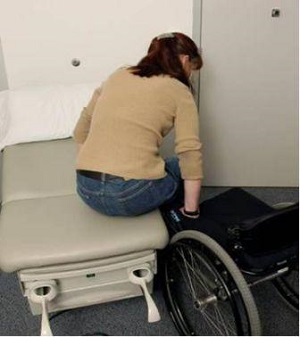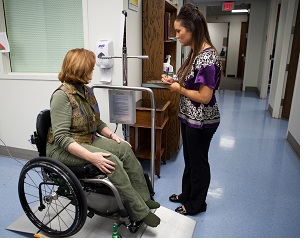Making Your Medical Office More Accessible to People with Mobility Disabilities
Health care providers can add two relatively inexpensive pieces of equipment to maker their offices more accessible and usable for people who have mobility impairments: An adjustable-height exam table and an accessible scale.
These generally qualify for tax credits or deductions.
Adjustable-Height Exam Tables
 These tables facilitate transfer for people with any kind of mobility impairment. In addition, the use of an accessible exam table may reduce the time required to use a lift team, lift equipment and/or transfer assistance from your staff.
These tables facilitate transfer for people with any kind of mobility impairment. In addition, the use of an accessible exam table may reduce the time required to use a lift team, lift equipment and/or transfer assistance from your staff.
Look for tables that have:
- At the least, the ability to lower to the height of a wheelchair seat– i.e., 17-19 inches from the floor.
- A handle or support (rails, straps, stabilization cushions, wedges, or rolled up towels) along one side of the table to stabilize and support the person during transfer and while on the table.
Accessible Scales
 These scales allow you to get an accurate and current weight measurement for a patient. This increases the quality of healthcare by providing more accurate data for diagnosis and medication prescription.
These scales allow you to get an accurate and current weight measurement for a patient. This increases the quality of healthcare by providing more accurate data for diagnosis and medication prescription.
Accessible scales can be used by people with and without disabilities, including wheelchair users, people with activity limitations, and people who are too large for a standard weight scale limit.
Tax Incentives to Improve Accessibility in Your Office and Practice
There are two types of tax incentives that can help cover the cost of making your office more accessible: tax credits and tax deductions.
1) A tax credit can be used for architectural adaptations, equipment acquisitions, and services such as signs language interpreters. This can only be used for adaptations and equipment for existing facilities; it cannot be used for the costs of new construction. (Title 26, Internal revenue Code, Section 44.)
a. Eligibility: Small businesses that have revenue of $1 million or less OR 30 or fewer full-time employees during the preceding tax year.
b. Amount: 50 % of eligible access expenditures that exceed $250 but do not exceed $10,250 for a taxable year.
c. Frequency: A business may take the credit each year that it makes eligible access expenditures.
d. Equipment: Many companies can inform you if their products are eligible for tax credit coverage.
e. Form: IRS Form 8826 Disabled access credit. (See attached.)
2) A tax deduction can be used for architectural or transportation adaptations that remove barriers. This applies to the removal of architectural or transportation barriers. (Title 26, Internal Revenue Code, section 190.)
a. Eligibility: A business of any size may use this deduction. Small businesses can use these incentives in combination with the tax credit.
b. Amount: The maximum tax deduction is $15,000 per year.
c. Frequency: A business may use this deduction each year that it expends money for making eligible access improvements.
d. Eligible types of barrier removal: Renovations under Section 190 must comply with applicable accessibility standards.
For More Information:
- Facts about Disability-Related Tax Provisions
- Access to Medical Care for Individuals with Mobility Disabilities
- Information and Technical Assistance on the Americans with Disabilities Act (ada.gov)
- Accessible Health Care (ADA National Network)
Development of these resources for healthcare providers has been funded by the National Institute on Disability and Rehabilitation Research (NIDRR), grant H133B060018.